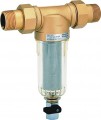Filtration speed
The amount of water that the filter is able to pass through itself per unit of time (of course, effectively purified in the process); usually stated in liters per minute. This parameter is largely related to the type (see above): for example, in jugs, the filtration rate usually does not exceed 0.5 L per minute, while for main devices that supply entire apartments, a throughput of tens or even hundreds of liters is required.
Note that it does not always make sense to pursue a high filtration rate. After all, other things being equal, finer cleaning takes more time; accordingly, the faster the filter works, the higher the chance that the quality of such cleaning will be relatively low. And devices that purify water efficiently and quickly usually have an appropriate price. Therefore, it is worth considering the purpose of the filter and, on the basis of this, determine the balance between the filtration speed and its quality when choosing. It is also worth keeping in mind the conditions of use: for example, if you need to filter low-quality tap water for drinking, it is better to sacrifice speed in favor of efficiency.
Cartridge replacement indicator
Index that indicates the need to replace the filter cartridge or carry out regeneration (depending on the type of device, see above). The specific device of the indicator may be different. So, in inexpensive models, mainly the simplest mechanical calendars are used, where the user need set the date manually. More advanced options may include built-in water meters, colour indicators, and even electronic systems that monitor the actual state of the cartridge. However, this function greatly facilitates the monitoring of the resource depletion anyway (for more details, see "Resource") and reduces the risk of missing the filter element replacement period.
Pressure gauge
The presence of
a pressure gauge — a device for measuring pressure — in the design of the filter.
This feature is provided mainly in main filters and sink models (see "Type"): it allows you to monitor the pressure in the water supply to which the device is connected. However, the accuracy of the pressure gauge is not very high, but such a device is still quite enough to at least monitor the general condition of the water supply system and detect critical rises and falls in pressure.

